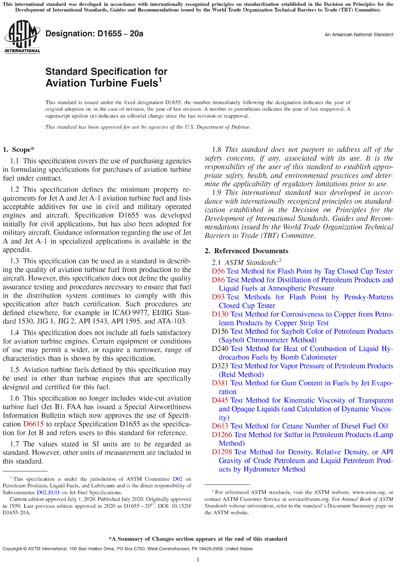Historical
ASTM D1655-20a
Standard Specification for Aviation Turbine Fuels
1.1 This specification covers the use of purchasing agencies in formulating specifications for purchases of aviation turbine fuel under contract.
1.2 This specification defines the minimum property requirements for Jet A and Jet A-1 aviation turbine fuel and lists acceptable additives for use in civil and military operated engines and aircraft. Specification D1655 was developed initially for civil applications, but has also been adopted for military aircraft. Guidance information regarding the use of Jet A and Jet A-1 in specialized applications is available in the appendix.
1.3 This specification can be used as a standard in describing the quality of aviation turbine fuel from production to the aircraft. However, this specification does not define the quality assurance testing and procedures necessary to ensure that fuel in the distribution system continues to comply with this specification after batch certification. Such procedures are defined elsewhere, for example in ICAO 9977, EI/JIG Standard 1530, JIG 1, JIG 2, API 1543, API 1595, and ATA-103.
1.4 This specification does not include all fuels satisfactory for aviation turbine engines. Certain equipment or conditions of use may permit a wider, or require a narrower, range of characteristics than is shown by this specification.
1.5 Aviation turbine fuels defined by this specification may be used in other than turbine engines that are specifically designed and certified for this fuel.
1.6 This specification no longer includes wide-cut aviation turbine fuel (Jet B). FAA has issued a Special Airworthiness Information Bulletin which now approves the use of Specification D6615 to replace Specification D1655 as the specification for Jet B and refers users to this standard for reference.
1.7 The values stated in SI units are to be regarded as standard. However, other units of measurement are included in this standard.
1.8 This standard does not purport to address all of the safety concerns, if any, associated with its use. It is the responsibility of the user of this standard to establish appropriate safety, health, and environmental practices and determine the applicability of regulatory limitations prior to use.
1.9 This international standard was developed in accordance with internationally recognized principles on standardization established in the Decision on Principles for the Development of International Standards, Guides and Recommendations issued by the World Trade Organization Technical Barriers to Trade (TBT) Committee.
Content Provider
ASTM International [astm]






